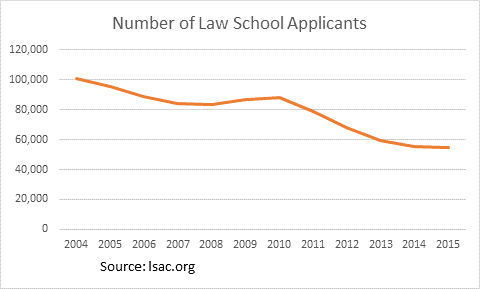enrollment
Lessons from Law Schools: Responding to a major market disruption in enrollment
This post is adapted from a recent article in University Business
There were more than 100,000 applicants to American Bar Association (ABA) accredited law schools in the fall of 2004. From 2001 to 2003 alone, the number of applicants rose almost 30 percent. During this time, most law schools could expect yearly increases in tuition and applications and often enjoyed improvements in selectivity and academic quality that resulted from the increased numbers of students seeking to study law with no increase in institutional aid. For many universities, the law school was seen as a cash cow since they were able to enroll bigger and better new 1L classes with very little expenditure of institutional financial aid.
By 2015, however, the number of applicants nationally had declined by 46 percent from the 2004 peak, a result of a shrinking job market for lawyers driven by cutbacks following the Great Recession and “offshoring” of some legal work to countries with lower labor costs. Most of the nation’s law schools were forced to change the way they recruited, admitted, awarded, and enrolled students in order to respond to this unprecedented drop in demand. For example, many progressed rapidly from giving very little consideration of the use of scholarships to, in a few short years, employing sophisticated financial aid leveraging strategies in order to meet enrollment goals. As a result of the severe disruption of their student markets, law schools have moved from a position where they typically lagged undergraduate programs in terms of market responsiveness, budget planning, and sophistication of recruitment practices to a position in which many law schools are now employing best-practice recruitment strategies to enroll their 1L classes.
Implications for the rest of higher education
Below are some “take-aways” law school administrators might have for other graduate or undergraduate programs on how to respond to a major market disruption. For further details on these suggestions, see the Enrollment Matters column in the October issue of University Business magazine.
- Regularly review your institutional mission and goals statements
- Evaluate the distinctive elements of your degree programs periodically
- Share recruitment ideas across campus
- Emphasize the institution’s value proposition
- Explicitly plan for the possibility of enrollment declines
- Consider reducing institutional aid where price elasticities suggest it could be revenue-positive
- Be strategic in decision-making in the academic program
Ultimately, law schools must come to grips with the near certainty that the reduction in demand for lawyers is permanent – a new normal for the law profession. Though the prospects for traditional undergraduate and graduate education are not nearly so dire, there are lessons to be learned from the ways in which law schools have responded to a severe disruption in the student market.
Are you looking for solutions to graduate or undergraduate enrollments?
Contact our experts at 800.876.11117 or email Ruffalo Noel Levitz to schedule a time to discuss your institution’s enrollment objectives. Learn how we can help you achieve your goals using research, industry expertise, and predictive analytics. We have served a wide range of graduate and undergraduate institutions across the United States and abroad.

